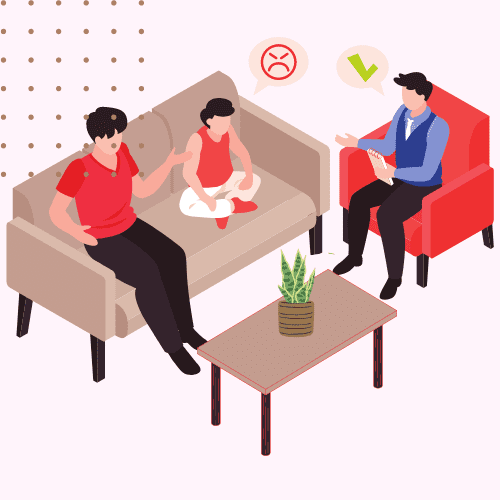Abusive Partner Test
3 Min Free Abusive Partner Test

We foster a nurturing environment where your voice can thrive!
WHAT TO KNOW?
What is an Abusive Partner Test in a Relationship?
An abusive partner test in a relationship is an assessment designed to help identify signs of abusive behavior within a partnership. It typically consists of a series of questions or scenarios that evaluate various forms of abuse, including physical, emotional, psychological, and sexual abuse. The purpose is to raise awareness, prompt self-reflection, and encourage individuals to seek support and resources if they suspect they are in an abusive relationship.
This is what the symptoms of an Abusive Relationship can look like...
- Presence of physical aggression, such as hitting or pushing
- Consistent use of tactics like gaslighting or guilt-tripping
- Frequent use of insults, name-calling, or demeaning language
- Deliberate efforts to isolate the partner from friends or family
- Attempting to control the partner’s actions, decisions, or finances
- Displaying extreme jealousy and possessiveness
- Forcing or pressuring the partner into unwanted sexual acts
- Controlling or manipulating the partner’s financial resources

WHO ALL CAN BENEFIT?
Who can derive advantages from this assessment of Abusive Partner test in Relationship?
Various individuals and groups can benefit from the assessment of an abusive partner test in a relationship. Individuals who suspect they may be in an abusive relationship can gain validation, awareness, and resources to seek help. Therapists and counselors can utilize the assessment to identify signs of abuse and provide appropriate interventions. Researchers and educators can study abusive dynamics to raise awareness and develop strategies for prevention and support. Ultimately, anyone interested in promoting healthy and safe relationships can benefit from this assessment.
Types of Assessment to Measure Abuse in Relationship
Abuse Questionnaires
These questionnaires consist of items designed to assess the presence and frequency of different forms of abuse within a relationship, including physical, emotional, sexual, and financial abuse.
Trauma Assessments
These assessments evaluate the impact of abuse on the victim’s mental and emotional well-being, assessing symptoms of PTSD and other trauma-related effects.
Safety Assessments
These assessments focus on evaluating the safety and risk factors within an abusive relationship, helping to determine the level of danger and potential harm to the victim.
Relationship Dynamics Test
This assessment examines the power dynamics, control, and manipulation within the relationship to identify signs of abusive behavior and coercion.
Clinical Interviews
In-depth interviews allow victims to share their experiences & offer detailed information about the nature and impact of the abuse they have endured.
Observational Assessments
Trained observers closely analyze the interactions, behaviors, communication patterns within the relationship to identify signs of abuse & power balance
Handling Abuse in a Relationship
Handling abuse in a relationship is a complex and challenging process. If you or someone you know is experiencing abuse, it is important to prioritize safety and seek professional help. Here are some general steps to consider:
- Ensure Safety: If immediate danger is present, prioritize personal safety by removing yourself from the abusive situation and contacting emergency services if necessary.
- Seek Support: Reach out to trusted friends, family members, or helplines specializing in domestic violence or abuse. They can provide emotional support, guidance, and help you access resources.
- Document Incidents: Keep a record of abusive incidents, including dates, descriptions, and any evidence (texts, photos, etc.). This can be important for legal purposes and seeking assistance.
- Develop a Safety Plan: Work with a professional, such as a therapist or counselor, to develop a safety plan tailored to your specific situation. This may include steps for leaving the abusive relationship or establishing boundaries to protect yourself.
- Seek Professional Help: Consult with a therapist or counselor who specializes in domestic violence or abuse. They can provide guidance, emotional support, and help you navigate the complexities of leaving or healing from the abusive relationship.
- Legal Support: If needed, consult with a lawyer or legal professional who specializes in domestic violence to explore legal options, such as obtaining restraining orders or filing for divorce.
- Build a Support Network: Surround yourself with supportive and understanding individuals who can provide emotional support and practical assistance during this challenging time.
- Focus on Self-Care: Prioritize self-care activities to heal and rebuild your emotional well-being. This may include engaging in therapy, pursuing hobbies, practicing relaxation techniques, and taking care of your physical health.
- Explore Resources: Research and access community resources such as support groups, shelters, hotlines, and counseling services that specifically address domestic violence and abuse.
- Develop an Exit Strategy: If appropriate and safe, work with professionals to plan a safe exit from the abusive relationship. This may involve securing housing, financial resources, and support networks.
Remember, handling abuse in a relationship can be complex, and professional guidance is crucial. Reach out to trusted professionals and support networks who can provide specialized assistance and help you navigate the process of leaving or healing from the abusive relationship.

